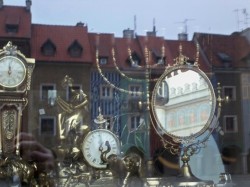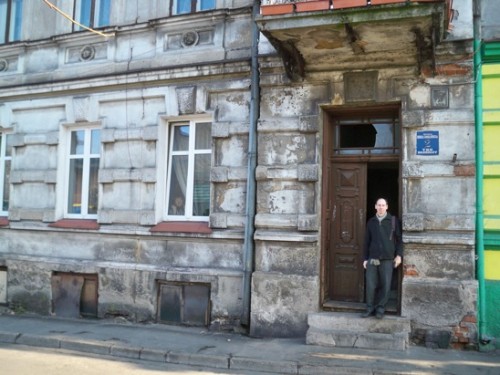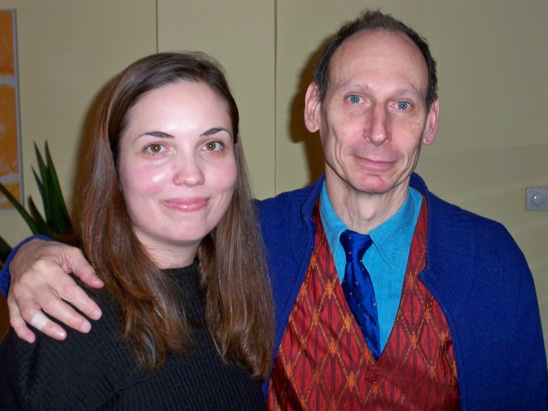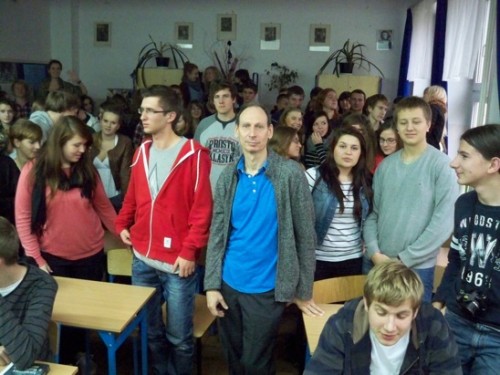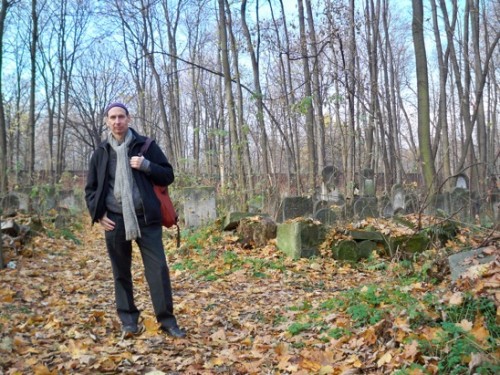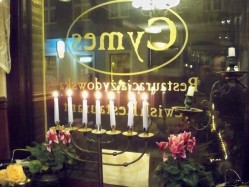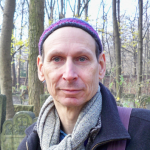By Richard Zimler
A Grandson of Polish Jews Returns to the Old Country
My mother’s father, Itzhak Gutkind, grew up in a three-story townhouse in Brzeziny, a small but bustling city at the center of Poland’s textile-producing heartland. Back then, at the end of the nineteenth century, Brzeziny’s colorfully painted row houses were home to a mishmash of 7,500 Jews, 5,000 ethnic Poles, 1,200 Germans, and several hundred Russians. Three thousand of the residents stitched garments in small factories, and a majority of the Jewish boys—including Izhak—trained as tailors.
Happily, Itzhak and his Brzeziny-born wife Genendel Kalish—my grandparents—emigrated to America long before the Nazi occupation of Poland. Eight of their brothers and sisters remained behind, however, and none of them would survive the Holocaust. Even today, 67 years since the end of the Second World War, one could say that Brzeziny represents an ongoing victory for the Nazis; like thousands of towns and cities across Poland, it remains Judenfrei—free of Jews.
It’s understandable, then, that when my Polish publisher proposed a book tour for their edition of my latest novel, The Warsaw Anagrams—set in the Warsaw ghetto in 1940 and 1941—my heart did a small dive toward panic. My mother had died several years before, but I could clearly see her throwing up her hands and exclaiming, “Don’t you dare go!” Like most Jews with roots in Poland, she and my grandparents always raged more bitterly against the Poles than the Nazis themselves, and they regarded all Poles as anti-Semitic to the core.
Despite Mom’s warning, I decided to go; I realized that a grandson of Polish Jews coming to Poland to promote a novel set in the Warsaw ghetto might prompt some discussion in the media of the country’s 3.3 million Jewish citizens who died in the Shoah. And so it was that on November 20, 2011, I became the first person in my family to walk Brzeziny’s slanting, potholed streets in nearly seventy years. And just before noon, I saw what I never thought I’d see: my grandfather’s house.
Standing in front of that grim, unpainted house—watching my vapor-puffs of breath form in the frigid air and thinking of how worried but astonished my mother would be—I felt as though I’d accomplished the impossible simply by being there. And I realized I was tingling with a heightened sense of self because it had been Hitler’s goal that no Jew should ever set foot in this town again. And, yet, here I was!
It was the local museum director, Paweł Zybała, who had discovered the address of my grandfather’s house and led me there. In posing together for a photograph, I put my hand over his shoulder, and he placed his arm around my back. A Jew and a Pole embracing in Brzeziny seemed a wonderful testament to how far Poland has come over the last decades. Yet, as I got in our car for the ride to Łódź, 20 kilometers away, Adam Drzewucki, the young, long-haired publicist assigned to chaperone me, told me, “One of the museum people just confided in me that the residents of Brzeziny are still very anti-Semitic.”
That revelation shocked me. Realizing how easily I could be fooled by my own enthusiasm, I decided to talk to all the journalists, bookshop employees, and readers I would meet on my tour about the current state of anti-Semitism. And yet I received so many contradictory answers over the next few days that it took me nearly to the end of my visit to make sense of what I’d heard.
Katarzyna Markusz, a 29-year-old freelance photographer who spent the last several years researching the blood-soaked history of the Jews of her hometown of Sokolow Podlaski, added an important nuance to my conclusions at our interview in Warsaw. Over tea at the MDM Hotel in busy Constitution Square, she told me, “We Poles say that the country is divided into two regions, A and B. A is everywhere to the west of the Vistula River [which passes through Warsaw and Krakow]. It is open-minded and relatively wealthy, and the people there look toward Western Europe. Poland B is backward, isolated, and more traditional, and its people look toward the East. In Poland B, anti-Semitism remains strong, while in Poland A, it is slowly disappearing.”
Unfortunately for Katarzyna, Sokolow is very definitely located on the B side of this psychological fault line. “Most people there have never met a Jew and still hate them!” she told me. She herself has paid a high price for uncovering the story of the town’s vanished Jewish community of 5,500, having frequently quarreled with both local authorities and family members. No one in Sokolow will hire her as a photographer.
Still, one recent triumph brought out her brilliant smile. With her dark eyes moistening, she said, “My campaign to save the abandoned Beit Midrash [room for study of the Old Testament]from destruction has been successful!”
After I congratulated her on that small but decisive victory, Katarzyna told me about the visit to a local primary school she’d recently organized for the Israeli ambassador and several children of Holocaust survivors. In a country of 40 million with no more than 25,000 Jews, none of the kids had ever seen a Jew before.
On the day after my conversation with Katarzyna—having been made aware that I might be something of a curiosity even in Poland A—I subverted the planned opening of my talk to students at a Warsaw public high school by first asking, “How many of you have ever met a Jew before?” Only about 10 of the 65 students in the classroom raised their hands.
Teachers at Maria Konopnicka High School had selected one of the students who had already read The Warsaw Anagrams to comment on the book and ask me questions as a way to open the session. To my relief, the student, Naomi Di Biasio, described the book as very moving in her sweetly hesitant English, but she and other students soon expressed two concerns that reveal, I think, important facets to the Polish perspective on the tragic fate of the country’s Jews.
Their first concern—expressed to me over and over on my tour—was that my portrayal of Poles in the book might have been too negative. In The Warsaw Anagrams, the narrator, an elderly psychiatrist named Erik Cohen, is denounced by Christian neighbors while in hiding and is arrested by Nazis. Unfortunately, it was a fate that awaited many Polish Jews. And, yet, the majority of Poles I spoke to seemed to truly believe that most of their parents and grandparents did their best to protect their Jewish neighbors.
According to Professor Bohdan Michalski, a Holocaust specialist at Warsaw University, however, the most reliable estimates are that about 5 percent of the Polish population—one person in 20—came to the aid of the country’s Jews. Another 5 percent would have actively collaborated with the Nazis.
“And the remaining 90 percent?” I asked him.
“They did nothing. They kept quiet.”
To the students at Maria Konopnicka High School, I said, “Before the Second World War, about 30 percent of the residents of Warsaw were Jewish.” Pointing around the room to every third student, I added, “You and you and you would have been Jewish. So don’t you think it was appropriate for me to include something in my book about those neighbors of yours who denounced you to the Gestapo, or who did nothing when you were forced into the ghetto and then sent to the death camps?”
I then addressed two other sensitive points that had already come up in interviews with journalists. I told the students that I didn’t write the novel to make them or any other Poles feel guilty, but instead to explore the day-to-day courage of those who were interned in the ghetto and who managed to retain their generosity, kindness, and even sense of humor. And I’d taken care to include two wonderfully brave Polish Christians in the book—a friend of Erik’s named Jasmine and her sister Lisa, who help him escape from Warsaw. Indeed, one of the most important questions raised by my novel might be: What is it about some individuals—about their upbringing, in particular—that enables them to risk their own lives to save others?
Although the students and I moved on to other topics, I wasn’t sure that all of them were satisfied with my reply, because I had learned by then that some Poles see themselves exclusively as victims of the Nazis and not as victimizers themselves. Although that’s not true, it is true—even if Jews with Polish roots are sometimes loathe to admit it—that the Nazis treated Poland with particular brutality and violence. About 2.5 million non-Jewish Poles were killed in the Second World War, 200,000 alone in the failed—but heroic—Warsaw Uprising, in which the Polish Home Army attempted to free the city from German occupation.
Bohdan Michalski made this perspective movingly clear to me when he confided over lunch one afternoon that his mother was four months pregnant with him when his surgeon father was arrested in a Nazi roundup of civilians and Polish resistance fighters. “This was in September of 1944, during the Uprising,” he told me, “and it was the last time my mother ever saw my father.”
Bohdan explained to me that his mother and other arrested women were led off to a temporary concentration camp while his father and a couple of hundred other men were taken into Gestapo headquarters. “At the end of the Uprising,” he added darkly, “their charred bodies were found in the yard behind the building.”
“But what could the Nazis have possibly gained from the death of your father?” I asked. “After all, a surgeon might have proved useful to them.”
Had he been hoping I’d ask my naïve question? With his eyes gleaming, Bohdan shot back, “Have you forgotten? The Nazis hated the Slavs as well! Especially the most educated ones.”
His simple but forthright answer made me realize that from Bohdan’s point of view—and maybe now from mine as well—my question revealed my prejudice against Poles. Indeed, the only question more absurd would have been for me to have asked him, “What had the Nazis to gain from killing all the Jews of Brzeziny and every other Polish town?”
Still, 90 percent of Poles survived the Second World War and only 10 percent or less of the country’s Jews survived—most, after enduring the horrific brutality and deprivations of the Nazi death camps.
The second concern expressed by many of my Polish readers was with the book’s plot, in which Erik vows to learn the identity of the Nazi—or Jewish traitor—who has murdered his grandnephew and other ghetto children. His transformation into an amateur sleuth gave them doubts because—as I soon realized—most Poles believe that mystery novels are, by nature, superficial entertainment. My reply was that I believed a mystery could be a serious, literary novel in the right hands and that, in any case, the mystery element in the story grew directly out of my research into the black market in the Warsaw ghetto, in which children were recruited as smugglers.
Later, in thinking about their concern, I realized that Jewish writers may feel more freedom to develop new and different ways to explore the enormous range of themes raised by the Holocaust for the simple reason that we are less likely to be accused of taking it lightly. Regarding the Shoah as a sacred and supremely solemn event was a characteristic of all the Polish readers, journalists, and bookshop workers I spoke to. It seems to me a wise and healthy attitude, especially in a country with a sinister B side to its sentiments toward Jews.
Near the end of my talk with students, when I asked them how prevalent anti-Semitism was in Warsaw, one long-haired girl raised her hand and told me forthrightly, “Anti-Semitism just isn’t a part of our lives.” When I expressed my doubts, the other students assured me that, for their generation, it’s a nonissue.
I still didn’t entirely believe them until I went to the small reception for me in the principal’s office. Around a table of butter cookies tasting just like the ones my father used to buy at our local Jewish bakery on Long Island, the French teacher, Marguerite, told me that she and several other teachers take seniors to Auschwitz on a volunteer basis at the end of every school year. “I know that being there makes real everything that we talk about with them,” Marguerite told me in her delicate, Polish-accented French. “You can tell from their silence how very deeply it affects them.”
The most moving moment on my six-day tour—more moving even than standing in front of my grandfather’s home—came when Naomi asked me about a particular scene near the beginning of The Warsaw Anagrams. While recalling the gentlemanly manners and cultured sensibilities of his long-dead father, Erik comes to understand that Nazis are trying their best to murder an entire way of life. This was a moment in the novel that struck Naomi as particularly powerful. After a brief hesitation, she asked me if, in a sense, Hitler might not have succeeded in his goal. After all, the Nazis nearly killed off Jewish culture in Poland; vestiges of it are visible only in a few select places.
Her implication created a knot in my gut, but as I looked around the room at the sixty teenagers waiting eagerly for my reply, a window seemed to open in my heart, and I had one of those rare moments when I knew exactly what I wanted to say.
“My being here is something I’d have never believed possible,” I told them in my quivering voice. “And Erik…he might not have believed it would be possible either. But I think he’d say that my being here today with you, in this classroom, just a couple of kilometers from where he was interned in the ghetto, is absolute proof that you and I will have the last word about Jewish culture in this country. We will decide what is dead and what is living, not Hitler or anyone who still thinks like him.”
Publication Information
- The Warsaw Anagrams by Richard Zimler (Corsair, 2011; first published in the United States by Overlook Press, 2012).
- Jewish Sokolow Podlaski, Katarzyna Markusz’s website on her work to uncover the Jewish history of her town.
Art Information
- "Antique Shop Window in Poznan with Menorah (and Central Square Reflected)," "At Grandfather’s House in Breziny," "With Katarzyna Markusz," "With Students at Maria Konopnika High School," "Jewish Cemetery in Warsaw," and "The Only Jewish Restaurant in Poznan" © Richard Zimler; used by permission
Richard Zimler was born in Roslyn Heights, a suburb of New York City, in 1956. He now lives in Porto, Portugal. Lorraine Berry's interview Richard Zimler: "The Subversive Side of my Personality" appeared in TW in May 2012.
Richard has published nine novels over the last 15 years. They have been translated into 23 languages and have appeared on bestseller lists in 12 countries. The Warsaw Anagrams, released this year in the United States, has been longlisted for the International IMPAC Dublin Literary Award, the richest prize in the English-speaking world.
He also recently published his first book of poetry, Love's Voice: 72 Kabbalistic Haiku. Four of his works—The Last Kabbalist of Lisbon, Hunting Midnight, Guardian of the Dawn, and The Seventh Gate—form the “Sephardic Cycle,” a group of inter-connected novels about different branches and generations of a Portuguese Jewish family.
An abbreviated version of this essay was published as “Welcome to Poland—It's Where My Family Were Killed” on December 22, 2011, in the Jewish Chronicle Online.

